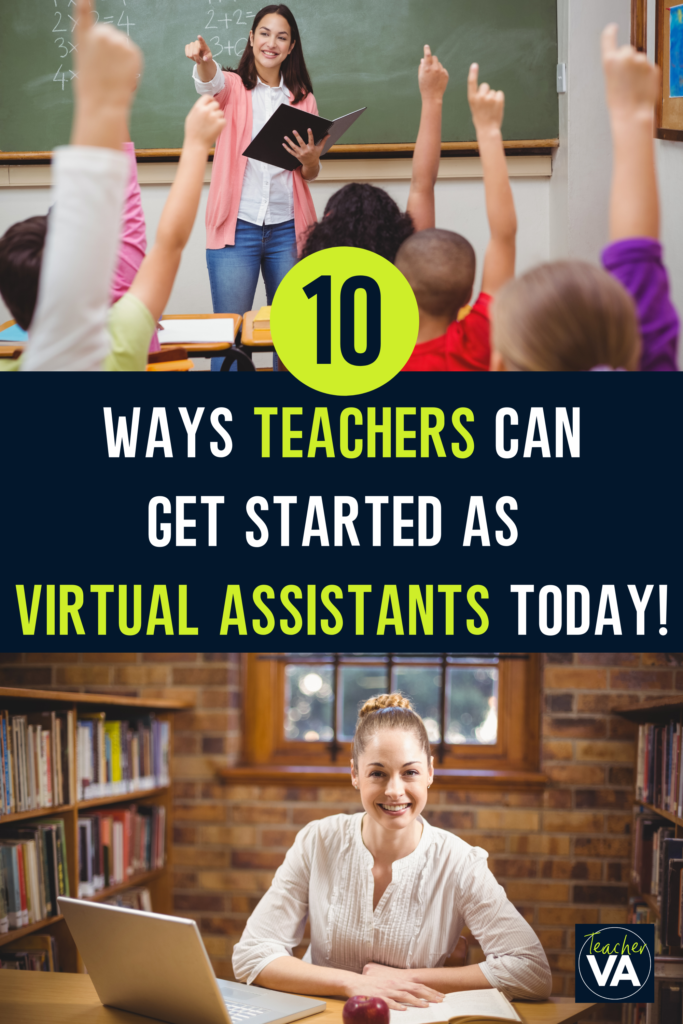Ready to get started as a virtual assistant? Here are 10 things you can do today to move forward building a VA business.
Becoming a virtual assistant doesn’t have to be hard, especially if you are just wanting to take on a client or two. To begin you just have to start setting balls into motion. Like a snowball, if you get the ball rolling, it will eventually catch some momentum and build on itself.
This post is all about starting today. Setting up your own business takes steps. You can run or you can stumble, but you have to move forward. For some, the mental blocks are going to be big, and you’re going to hesitate and doubt your abilities at every turn. I say this a lot, but we all know that teachers are often the worst students, so I’m going to say it again.
A teacher’s mind is valuable.
Your work ethic is admirable.
And…your skillset is incredibly employable

As you work through this list, you can start small by simply listening to podcasts on your way to school, or you can jump in with full force and begin taking a course on a specialized skill and building a website. The path is up to you, but spend some time on your virtual assistant business at least every other day.
So what should you do first? Okay, folks. Here we go…
1| Pick your VA path
Let’s start by setting a realistic goal.
We aren’t all striving for the same results. Although some teachers may have found this post as they sought out summer job ops, others may be looking for a way out of the profession altogether. Depending on your path, you will need to be doing different things.
Are you becoming a virtual assistant to supplement your teacher income? Then sit down and journal for a bit on how much money you want to make and how many hours you can dedicate to that process (be realistic). If you get paid $30-$40 per hour, how many clients will it take to reach your goal?
Don’t forget benefits!
If you want to leave the classroom, you need to spend some time with your pay stub. Do you want to replace your income, or do you just want to save up some money to allow you time to find a job in a different industry? Take a really good look at that pay stub and do some math.
If you are struggle-bussing to figure out the numbers, go to your HR department and ask them to explain your paystub to you. Figure out how much of your money is going to taxes, retirement, etc. How much money is the school putting into retirement? Consider how much they are really paying you, not just how much you are taking home.
If you are planning to work for yourself as a VA, make sure you consider health insurance and any other benefits that you may need.
In my situation, my husband was able to cover health insurance, so I just needed to make up enough money to cover my salary and put some money toward retirement. I also decided to bring my kids home for at least a couple of days a week; that dramatically cut down on our daycare bill. We went from spending over $2,000 per month on daycare to spending just over $600. Take these things into consideration when deciding how you want to move forward.
(Note: remember you will have to pay taxes on your VA income, so make sure to calculate that into your totals)
2| Start listening to online business podcasts
I spent over a year listening to online business podcasts before I ever started my virtual assistant business. Since I was in the classroom, I focused on podcasts that included elements of teacher businesses, but I also didn’t want to be limited to only teacher-centered options. Over the years, I’ve developed a list of my favorite podcasts.
The full list is automatically dropped into your inbox when you sign up for the FREE 5-DAY EMAIL SERIES called Virtual Assisting Defined (with teachers in mind).

3| Set up a LinkedIn profile
Although teachers are not as familiar with the LinkedIn world, it is a vivacious community of business owners looking to connect. By simply setting up an account and posting a couple times a week, you could connect with people who need a virtual assistant.
As virtual assistants, our market is the business world (not just other teachers), so we need to hang out where the business world hangs out, and that is LinkedIn.
When my sister decided to become a virtual assistant after having her fourth child, she told a few of her friends in business about her goals. They asked her if she had a LinkedIn profile they could refer people to. She didn’t, but she quickly made one. She began working with her second client (a local realtor) after being found on LinkedIn.
People are out there and they are looking for virtual assistants. We just have to make sure people know that we are taking on clients.
4| Create a portfolio
A portfolio is an online version of a resume. Your portfolio displays your work and demonstrates client successes.
A portfolio can be a simple PDF created using Canva, or you can create a website-based portfolio. Another option is to create a Facebook-based portfolio. I personally think you should have both a PDF version of your portfolio and a website (eventually). If you are only hoping to get 1-2 clients, don’t worry about the website unless you want to build that skillset. Instead, focus on your pdf portfolio and LinkedIn profile.
No matter what you decide, I want your portfolio to focus on your audience (not on you). What do they want to see and hear? What do they need to know about you? This is your opportunity to make sure you are appealing to the right people.
In my portfolio, I was very blunt about what I wanted to do and who I wanted to work with. I want to be in the driver’s seat in my business (maybe because I rarely felt that way in the classroom). I know how I like to work, and I wanted my clients to trust my vision.
Interestingly, I’ve had clients literally read the words from my portfolio back to me because they found them inspiring.
It is a new thing for teachers to be able to specify who they want to work with and how they want to work. Your portfolio (no matter where it is located) is your opportunity to address exactly how you want to run your business.
5| Do testimonial projects.
This one is simple. Try out different kinds of skill sets you are interested in offering as services. Complete the service for free, but ask for a testimonial in exchange for your efforts.
To find testimonial projects, consider some of these options.
- Offer to make a handout or pdf for someone else in your school district. Practice using your design skills to beef up some resources for your fellow teachers. You can then put before and afters on your site or in your post.
- Write a guest blog post for your favorite blog or website. Many websites offer opportunities for guest posts. Go to some of your favorites and reach out to them via their contact form. Ask if you can write for them. But don’t just ask if you can write, tell them what you want to write, and how it will benefit their business. Do the same for your favorite podcasts.
- Offer to edit a video for a fellow teacher. Again, this is a way to practice new skills. Teachers use video all the time, and some people are not comfortable being on video. You can edit a current video, or you can offer to re-imagine an already created video. Either way, you are helping out your friend, and getting some great experience.
- Contact your favorite Teachers Pay Teachers (TpT) seller and offer to help them. Teacher-sellers are busy people. Many of them teach during the day and create content in the margins. Many of my early clients were Teachers Pay Teachers sellers, and they need help all the time. Offer to make some pins for their newest content or to edit something for them in exchange for a testimonial.
6| Take a course on a specialized skill
Search online for courses in the specialized skills you want to pursue. You can also use course platforms like Udemy or Skillshare to take courses. If you are hoping to work with online businesses, taking courses and specializing in skills will set you apart from other new virtual assistants.
Some of my favorite courses I have taken to develop specific skill sets come from business owners I trust and enjoy learning from. These are some of the courses I’ve taken…
- Copy Cure (Copywriting)
- Websites By Day (Build a Website from Scratch)
- The Teacher VA Canva Masterclass (Learn how to use Canva-a DIY design program)
- Live Free Academy (This is the virtual assisting training course I took!)

7| Look for opportunities in your local community
Local businesses need virtual assistants, especially if you can offer a service like graphic design, web design, or Facebook Ads management.
Just like with the realtor and the contractor I met with (see #10 below for THAT story), many businesses see the need for a virtual assistant, but they don’t know how to find one, or they don’t know how a virtual assistant can help them.
I have personally seen a need for a VA in four different local businesses this week. One of them needs someone to handle their invoicing, one needs someone to help them with calendar management, and two of them needs help with their website. Don’t be afraid to reach out to these businesses and tell them what you can do to help them. Even if they don’t want to work with you right away, at least you are on their radar.
8| Contact your favorite online sellers/businesses
Sellers on platforms like Teachers Pay Teachers and Etsy are often solopreneurs who are building a business on their own. They are running themselves ragged trying to do all the things.
Reach out to the Etsy store you bought that piece of jewelry from and ask if they need any help. If you have purchased anything for your classroom from TpT, contact the seller and tell them you are starting a virtual assistant business, love their products, and would love to work with them.
Even when an online business seems to have all their ducks in a row, they are often working with a business of one, and looking for a VA is often overwhelming and time consuming. If you happen to stumble into their email inbox with a service they are interested in hiring out, it is a win win for you both!
9| Create your own website using THIS FREE PROGRAM
Start building as many tactical skills as you can because if there is one thing I know about teachers it is that we need to feel qualified to take big leaps, so this is what I want you to do.
If creating a website seems overwhelming consider joining Website By Day. This day-by-day, click-by-click course will help you navigate picking a domain and hosting provider, setting up plugins, using a theme builder, setting up a blog, and creating a store. It takes 21 days to complete and each day only requires an hour or less of work. This course is perfect for someone who is just starting out.
(PS. If you choose to purchase Websites By Day, on the checkout page, you’ll most likely have the opportunity to add No BS Branding to your purchase as well. This is a branding course for people who are just getting started in online business. If that’s you, make sure to click the little box!)
You will…
- start creating a digital presence for your brand.
- be creating an online portfolio.
- learn the backend of WordPress (which will help you work with clients).
- develop a specialized skill set (web design).
- get an opportunity to learn about email management systems like Convertkit.
I like this route for getting started because you will learn so much through the process of building your own site, and all of those are skills that you can take to the bank as a VA.
10| Tell people
Telling people is often the last thing teachers do when they start a side business because they are afraid of what people are going to think, but telling people what you are doing is one of the best ways to find people who need your help.
If you don’t feel comfortable telling the people you are closest to or blasting out a Facebook post, then create some business cards through Canva and start carrying them around with you. Walk into some of the small businesses in your town and let them know what you’re doing. Old fashioned face-to-face marketing goes a long way!
Eventually, when you start building some confidence, tell your friends and family, and tell them you’re open to new clients. Your family and friends may be able to make the introduction that leads to your perfect client! Let them help you.
Also, just be aware and tell people what you do. I actually had two potential clients walk through my front door.
My husband and I were considering either remodeling or selling our house, so in one week we met with our builders and our realtor. When they came in to talk, the conversation turned to what I do, so I mentioned that I am a virtual assistant.
They both (I’m not kidding…BOTH) said they were in the market for a VA, but they didn’t even know where to begin finding one. It was crazy.
This is a mindset shift.
Trust me, I understand the mindset issues that go along with being a teacher who is looking for *more.* You are not the first teacher to be embarrassed, uncertain, or concerned about considering a job or side hustle outside your classroom, but if this is something that is really holding you up, consider one of these blog posts.
- 5 Reasons Teachers Need a Side Hustle (that have nothing to do with money)
- My Journey from Teacher to Virtual Assistant: 3 lies I had to overcome (a guest post from a teacher turned VA)
- Why I can’t leave teaching (3 lies I let hold me back) (a guest post from another teacher who became a VA)

Thank you for reading this post series. Now let’s get started. If this is your first interaction with Teacher VA, check out the other posts in this series below!
#1: What is a VA and who is hiring one?
#2: What tasks are virtual assistants often hired for?
#4: Why do teachers make great virtual assistants?
#5: 10 ways to get started as a virtual assistant today! (This is the post you’re on now!)



